How to Make Cheese From Raw Sheep Milk
These recipes were learned from an Sardenian/Italian cheesemaker with years of expertise (I wwoofed on his farm in the heel of the boot of Italy). So much of cheesemaking is about "feel" and subtleties, but here are the objective steps.
WINTER PECORINO —
One batch of milk, two temperatures, three mold pressures, four different cheeses!
-
Formaggio Primo Sale (FPS): "Cheese Before It's Salted" – a tasty soft cheese not meant to be aged.
-
Pecorino Stagionato (PS): "Aged Sheep Cheese"— a harder, aged version of FPS
-
Pecorino Duro (PD): "Hard Sheep Cheese" — a hardened, aged verson of PS, meant to be grated into pastas, etc.
-
Ricotta Fresca (RF): "Fresh ReCooked" — a very soft cheese meant to be eaten within a day or two.
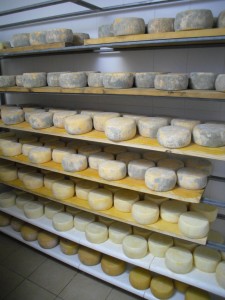
Kilos and kilos of cheese heaven at various stages of aging.
Traditionally, these cheeses were made only when the outdoor temps would keep them cool. Now, it's possible to make them year-round, but this farm sticks to traditional ways.
In the winter, the cheese-making milk is heated twice. As I understand it, different proteins and fats react at different temperatures. First the milk is heated to a low temperature, rennet is added, and the curds are either pressed gently into molds (FPS), or firmly into molds (PS, PD). Then the remaining whey is heated again to a much higher temperature, new curds form, and these are gently drained in molds (RF).
WINTER CHEESE, Part I
(based on 60L of milk production)
-
Filter raw milk twice through cheesecloth.
-
Heat milk to a minimum of 36 °C (97 °F), and absolutely no more than 40 °C (104 °F), in a stainless steel pot.
-
Add two capfuls of rennet (about two teaspoons), stir, cover, and wait 30-45 minutes to allow curds to form.
-
Cut the curds with a knife in a cross-hatch pattern (several parallel cuts in one direction, followed by several perpendicular cuts).
-
Stir the curds quickly and vigorously, breaking them into very small pieces.
-
Prepare a space where your curds can drain. It is important to catch all the whey that drains off the cheese.
Formaggio Primo Sale:
-
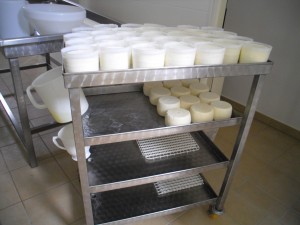
The rolling cart where cheese is left to drain for a few days. On the top level in the plastic baskets, you can see the cheese we just made. On the middle level is cheese from the previous day that has been removed from the basket mold, turned, and salted. On the bottom are the plastic racks that the plastic baskets sit on during their first day of draining. On the left edge of the cart you can see the two plastic buckets catching the drained whey. (Note: this is not the whey used for ricotta production. In this case it is a mess prevention strategy.
Submerge a mold basket into the curds. Slowly and gently scoop the curds into the basket, ensuring as much whey as possible remains distributed throughout the curds. (This is supposedly the secret to a wonderful, soft texture.) Make sure to flatten off the top for a symmetrical cheese that drains well.
-
Transfer the mold basket to a surface where it can continue to drain. Don't forget — catch the whey that drains off!
-
After ten minutes, gently dump the formed cheese into the palm of your hand, flip it over, and place it back in the basket (upside down). Continue to drain.
-
Leave to drain overnight at room temperature.
-
The following day, you can remove the cheese from the mold and eat it. If you like, you can rub the outside with coarse salt for flavor. If you are not going to eat the cheese right away, refrigerate it, ideally turning every day.
Pecorino Stagionato/Duro:
-
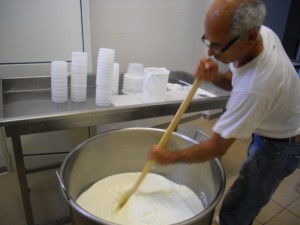
The cheesemaker stirring the curds with a giant, wooden paddle. In the background are some of our cheese making supplies – plastic basket molds.
Scoop the curds into a basket mold. Pack the curds down firmly with your fingers. Add more curds, packing until the basket if full and the top of the cheese is flat.
-
Transfer the mold basket to a surface where it can continue to drain. Don't forget — catch the whey that drains off!
-
After ten minutes, gently dump the formed cheese into the palm of your hand, flip it over, and place it back in the basket (upside down). With your fingers, break up the curds and repack them down hard again. Continue to drain.
-
Leave to drain overnight at room temperature.
-
The following day, remove the cheese from the mold. Before turning it, rub the outside with coarse salt. It is my understanding that this is a catalyst for the aging process. I'm told you can also soak the cheese in salt water. Place the cheese upside down and allow it to drain another day.
-
On the third day, flip the cheese and transfer to a 14 °C (57 °F) cellar. Any warmer, and the cheese will age (ferment) too quickly. The over-activity of the organisms will crack the cheese. Any cooler, and the aging process will stall.
-
On the fourth day flip the cheese. On the fifth day flip the cheese. And so on for up to a year for Pecorino Stagionato (remember, it is getting harder every day, so after a month it's up to you when you want to eat it). For Pecorino Duro, age from six months onward. Blue mold will likely grow on the rind of the cheese. Before eating, simply scrub it with a brush under running water.
WINTER CHEESE — Part II
(based on remaining and collected draining whey from ==Part I)
Ricotta Fresca:
-
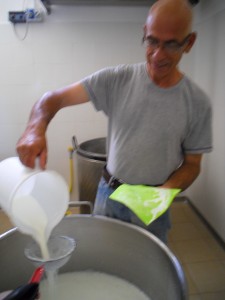
The secret (okay *a* secret) to good cheese? Filter, filter, filter…
If you don't have time to make Ricotta the same day that you make FPS and/or PS/PD, refrigerate the whey overnight.
-
Filter the whey before heating — a standard, mesh kitchen strainer will do. Obviously the smaller weave the better.
-
Heat the whey to 85 °C (185 °F) in a stainless steel pot. At 60 °C (140 °F), add a handful of salt.
- Once the whey has reached 85 °C (185 °F), remove from heat. To increase the ultimate volume, you can add 2L of milk at this point. It isn't necessary, but it will double the amount of Ricotta Fresca produced.
- Cover and let sit for 30-45 minutes.
- Stir curds gently and slowly to keep cheese soft.
- Drain and enjoy! (Or place in container for later use).
SUMMER PECORINO —
One batch of milk, one temperature, one mold pressure, one cheese!
Cacioricotta: "Cheese cooked" – a semi-hard, slightly sweet cheese.
Traditionally, this process was used to make cheese in summer, because the result kept well without refrigeration. If you have a fridge, extend the cheese's life by keeping it chilled.
In the summer, the cheese-making milk is heated once to a high temperature. When it cools to "warm," rennet is added, and the curds are pressed gently into molds.
SUMMER CHEESE
Cacioricotta:
(based on 60L of milk production)
-
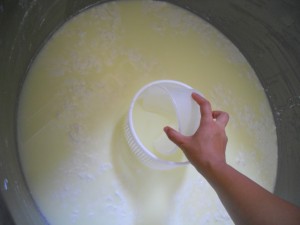
Draining the whey out of the curds using a scoop and a plastic basket mold submerged in the curds and whey.
Filter raw milk twice through cheesecloth.
-
Heat milk to 92 °C (198 °F) in a stainless steel pot.
-
Cool milk to between 43-45 °C (108-113 °F).
-
Filter milk again.
-
Add two capfuls of rennet (about two teaspoons), stir, cover, and wait 30-45 minutes to allow curds to form.
-
Using the bottom of a strainer, skim the flimsy, puffy, bubbly stuff off the top of the curds and discard.
-
Stir curds to break into small bits.
-
Gently turn curds by hand to get curds to settle and separate from whey.
-
Drain enough whey to make collecting curds easy. (Like drinking enough milk out of your cereal bowl to get at the remaining cereal…) Tip: submerge a strainer or mold basket and scoop the whey from the center of the strainer.
-
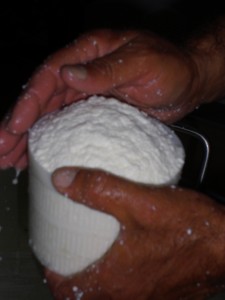
The master at work – gently but firmly forming up some delicious Cacioricotta.
Gently scoop curds into a basket mold, using even but light pressure to form a dome on the top of each one. Rotate the mold as you work to ensure even texture.
-
Transfer the mold basket to a surface where it can continue to drain.
-
After ten minutes, gently dump the formed cheese into the palm of your hand, flip it over, and place it back in the basket (upside down). Continue to drain.
-
Leave to drain overnight at room temperature.
-
The following day, remove the cheese from the mold. Before turning it, rub the outside with coarse salt. It is my understanding that this is a catalyst for the aging process. I'm told you can also soak the cheese in salt water. Place the cheese upside down and allow it to drain another day.
-
On the third day, flip the cheese and transfer to a 14 °C (57 °F) cellar.
-
On the fourth day flip the cheese. On the fifth day flip the cheese. And so on. I'm told you can eat it until the cheese becomes too hard, at which time you can grate it into pasta!
So, there you have it: how to make cheese from sheep's milk! May you enjoy years of delicious, amazing cheese!
How to Make Cheese From Raw Sheep Milk
Source: https://halftheclothes.com/how-to-make-cheese-with-sheeps-milk-3-pecorino-cheese-recipes/